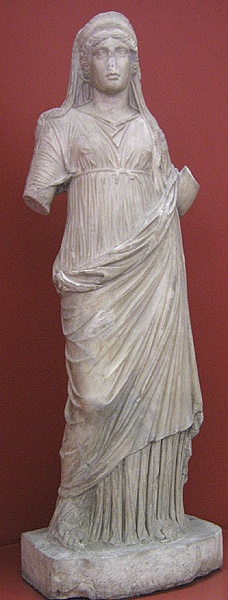☆ Ancient Fashion ☆ c. 396 B.C – 395 A.D.

Unknown Author, Young woman making an offering, 1st century CE, Museo archeologico nazionale di Napoli, ARTstor, http://library.artstor.org
Standard Clothing for the Roman Woman
Most clothing items were made from wool or linen until cotton was introduced around the 2nd century B.C. After that time cotton was often mixed with the linen for its luster and draping qualities. Silk became available at the end of the 1st century B.C. but was very costly so only the very wealthy could afford it.
Roman women usually wore undergarments consisting of a loincloth called a subligari and a band of fabric, and the strophium, that supported the bust like a sports bra or a bathing suit. Over this there were several layers of sleeved tunics. Finally, there was a pallus which wrapped around the body. The pallus acted like a shawl and could be pulled over the head like a veil for modesty. In the image below you can see an example of a woman in her tunic with the pallus draped over her head and around her body.

Unknown artist, Rhea hands a stone to Kronos, 2nd century CE, Musei capitolini, ARTstor, http://library.artstor.org
Public Attire
Married women of status would, in addition to covering their heads in public, wear a special garment called a stolla. A stolla was a sleeveless overdress worn over the tunics and was very gathered at the bottom. In the image below, Empress Faustina, is wearing a stolla evidenced by the heavy pleating at the base of the statue. Her pallus is wrapped around her.

Unknown artist, Faustina the Elder, 140-160 CE, The J. Paul Getty Museum, http://www.getty.edu/art/gettyguide/artObjectDetails?artobj=7642
The next image is another sculpture of a Roman matron with the top of the stolla visible. These are both good examples of how a matron of status would have been dressed out in public.

Unknown artist, Untitled, 2nd century CE, http://www.vroma.org/images/raia_images/index5.html
Hairstyles and Accessories
Matrons would wear their hair drawn back simply with a woolen band called a vitta. When a woman became the head of her family she would wear her hair in a distinctive style known as the tutulus, where the hair was drawn up and back in a conical shape. Other methods of fashioning hair included the use of fillets and coronets.
Roman women’s hairstyles started simply like the image on the left. The hair was often drawn back with soft waves. They became far more elaborate as time went on. By the end of the 1st century B.C. they were curling, braiding and styling them more like the image on the Right. As the Germanic tribes were conquered to the North, women also began dying their hair blonde or wearing wigs made from blonde captives hair. Towards the end of the period the hairstyles again trended toward the simple.

Unknown artist, Head of Giulia di Tito (Portrait of a Woman; Bust of a Lady), 1st century CE, Galleria degli Uffizi, ARTstor, http://library.artstor.org

Unknown artist, Bust of the Empress Sabina, Wife of the Emperor Hadrian (Modern Copy), c. 135 CE (copy second half of the 18th century, probably 1773-1774), Museo Pio-Clementino, ARTstor, http://library.artstor.org
Women had limited opportunities in Roman society. They could serve in religious orders or become wives and mothers. Otherwise they were limited to being nurses, maids, musicians, barmaids or prostitutes. In general the garments worn by all the statuses and professions would have been very similar. The differences would have been in quality of fabrics and the use of the vitta and stolla for the matrons.
The exception would have been prostitutes or women divorced because of adultery. Not only were they not allowed to wear the vitta and stolla, but instead they had to wear just a plain white toga.
Widows in mourning would replace the pallus with another draped garment called a rincinium which was likely dark colored. In addition they would wear a dark colored square on their hair. These were worn for at least a year.
Since status was so important, women displayed their family status on the form of their clothing and accessories by wearing brightly colored and expensive fabrics as well and lots of bracelets, headpieces, rings, necklaces and other jewelry. At one point, the senate felt these displays were so ostentatious in the midst of the Punic wars, that they passed the law Lex Oppia in 215 B.C. that was later reversed. The law restricted the amount of gold a woman could wear to half an ounce and also restricted the use of multiple colored tunics.
Other accessories were handbags, fans, and sunshades for the outdoor games. They also carried a variety of handkerchiefs used for different things. A woman would have one size for wiping sweat and another for use as a napkin. Shoes were the same for men and women with sandals (sandalas), boots and a type of slipper called a soccus.
Roman Women’s fashion continued to have a strong impact and influence on subsequent cultures. From the Byzantine empire to modern day, fashion has benefited from the advancements in elaborate draping, hairstyling and accessorizing.
-Rachel
Summary of Terms
Sources:
Tortora, Phyllis G., and Eubank, Keith. Survey of Historic Costume. Fifth edition. U.S,A. Fairchild Books. 2010. Print. Chapter Four.
Encyclopedia Britannica, http://www.britannica.com/EBchecked/topic/338333/Lex-Oppia
